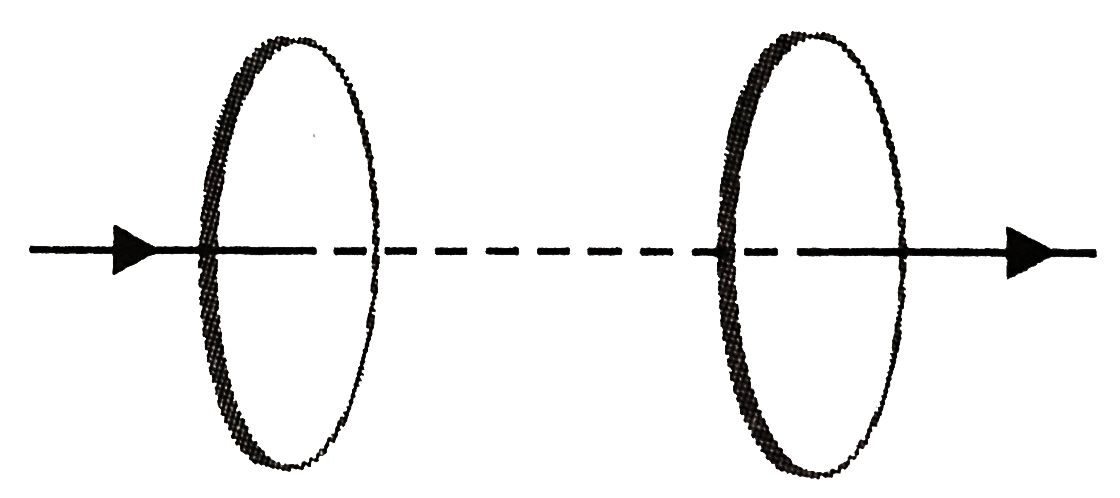A parallel capacitor is being charged by an external source. Show that the sum of conductor current and displacement current has the same value everywhere in the circuit.
To show that the sum of the conductor current Ic and the displacement current Id has the same value everywhere in the circuit, we can follow these steps:
Step 1: Understand the Concept of Displacement Current
The displacement current is defined in the context of a changing electric field in a capacitor. It is given by the equation:
Id=ϵ0dΦEdt
where ΦE is the electric flux.
Step 2: Calculate the Electric Field in a Parallel Plate Capacitor
For a parallel plate capacitor, the electric field E between the plates is given by:
E=σϵ0
where σ is the surface charge density. The surface charge density can be expressed in terms of the charge Q on the plates and the area A of the plates:
σ=QA
Thus, we can rewrite the electric field as:
E=Qϵ0A
Step 3: Calculate the Electric Flux
The electric flux ΦE through the area A is given by:
ΦE=E⋅A=(Qϵ0A)A=Qϵ0
Step 4: Differentiate the Electric Flux with Respect to Time
To find the displacement current, we need to differentiate the electric flux with respect to time:
dΦEdt=ddt(Qϵ0)=1ϵ0dQdt
Step 5: Substitute into the Displacement Current Formula
Now we substitute this result into the formula for displacement current:
Id=ϵ0dΦEdt=ϵ0(1ϵ0dQdt)=dQdt
Step 6: Relate Displacement Current to Conductor Current
The rate of change of charge dQdt is equal to the conduction current Ic:
Ic=dQdt
Step 7: Show the Relationship Between the Currents
From the above steps, we can see that:
Id=Ic
Thus, the sum of the conductor current and the displacement current is:
Ic+Id=Ic+Ic=2Ic
However, since Id=Ic, we can conclude that:
Ic+Id=Ic
This shows that the sum of the conductor current and the displacement current is constant everywhere in the circuit.
Conclusion
Therefore, we have shown that:
Ic+Id=constant
---
The displacement current is defined in the context of a changing electric field in a capacitor. It is given by the equation:
Id=ϵ0dΦEdt
where ΦE is the electric flux.
For a parallel plate capacitor, the electric field E between the plates is given by:
E=σϵ0
where σ is the surface charge density. The surface charge density can be expressed in terms of the charge Q on the plates and the area A of the plates:
σ=QA
Thus, we can rewrite the electric field as:
E=Qϵ0A
The electric flux ΦE through the area A is given by:
ΦE=E⋅A=(Qϵ0A)A=Qϵ0
To find the displacement current, we need to differentiate the electric flux with respect to time:
dΦEdt=ddt(Qϵ0)=1ϵ0dQdt
Now we substitute this result into the formula for displacement current:
Id=ϵ0dΦEdt=ϵ0(1ϵ0dQdt)=dQdt
The rate of change of charge dQdt is equal to the conduction current Ic:
Ic=dQdt
From the above steps, we can see that:
Id=Ic
Thus, the sum of the conductor current and the displacement current is:
Ic+Id=Ic+Ic=2Ic
However, since Id=Ic, we can conclude that:
Ic+Id=Ic
This shows that the sum of the conductor current and the displacement current is constant everywhere in the circuit.
Therefore, we have shown that:
Ic+Id=constant
Similar Questions
A capacitor, made of two parallel plates each of plate area A and separation d, is being charged by an external ac socurce. Show that the displacement current inside the same as the current charging the capacitor.
View SolutionA capacitor, made of two parallel plates each of plate area A and separation d, is being charged by an external ac socurce. Show that the displacement current inside the same as the current charging the capacitor.
View Solution
Knowledge Check
The conduction current is the same as displacement current when the source is
Aac onlyBdc onlyCeither ac or dcDneither dc nor ac
A capacitor has been charged by a DC source. What are the magnitude of conduction and displacement current when it is fully charged?
View SolutionA capacitor has been charged by ad.c. source. What are the magnitudes of conduction and displacement currents, when it is fully charged?
View SolutionFig. shows a capacitor made of two circular plates each of radius 12 cm and separated by 5.0mm. The capacitor is being charged by an external source (not shown in the figure). The charging current is constant and equal to 0.15A.
(a) Calculate the capacitance and the rate of change of potential difference between the plates.
(b) Obtain the displacement current across the plates.
(c) Is Kirchhoff's first rule valid at each plate of the capacitor ? Explain.

View SolutionFigure shows a capacitor made of two circular plates each of radius 12cm, and separated by 5.0cm. the capacitor is being charged by an external source (not shown in the figure). The charging current is constant and equal to 0.15A
(a) Calcuate the capacitance and the rate of change of potential difference between the plates
(b) Obtain the displacement current across the plates
(c) Is kirchhoff's first rule(junction rule) vaild at each plate of the capacitor ? Explain.
 .
.
View SolutionA parallel plate capacitor 20 μF is being charged by a voltage source whose potential is changing at the rate of 3 V/s. The conduction current through the connecting wires, and the displacement current through the plates of the capacitor, would be, respectively:
View SolutionA parallel - plate capacitor is being charged.Show that the displacement current across an area in the region between the plates and parallel to it is equal to the conduction current in the connecting wires.
View SolutionA parallel - plate capacitor is being charged.Show that the displacement current across an area in the region between the plates and parallel to it is equal to the conduction current in the connecting wires.
View Solution
